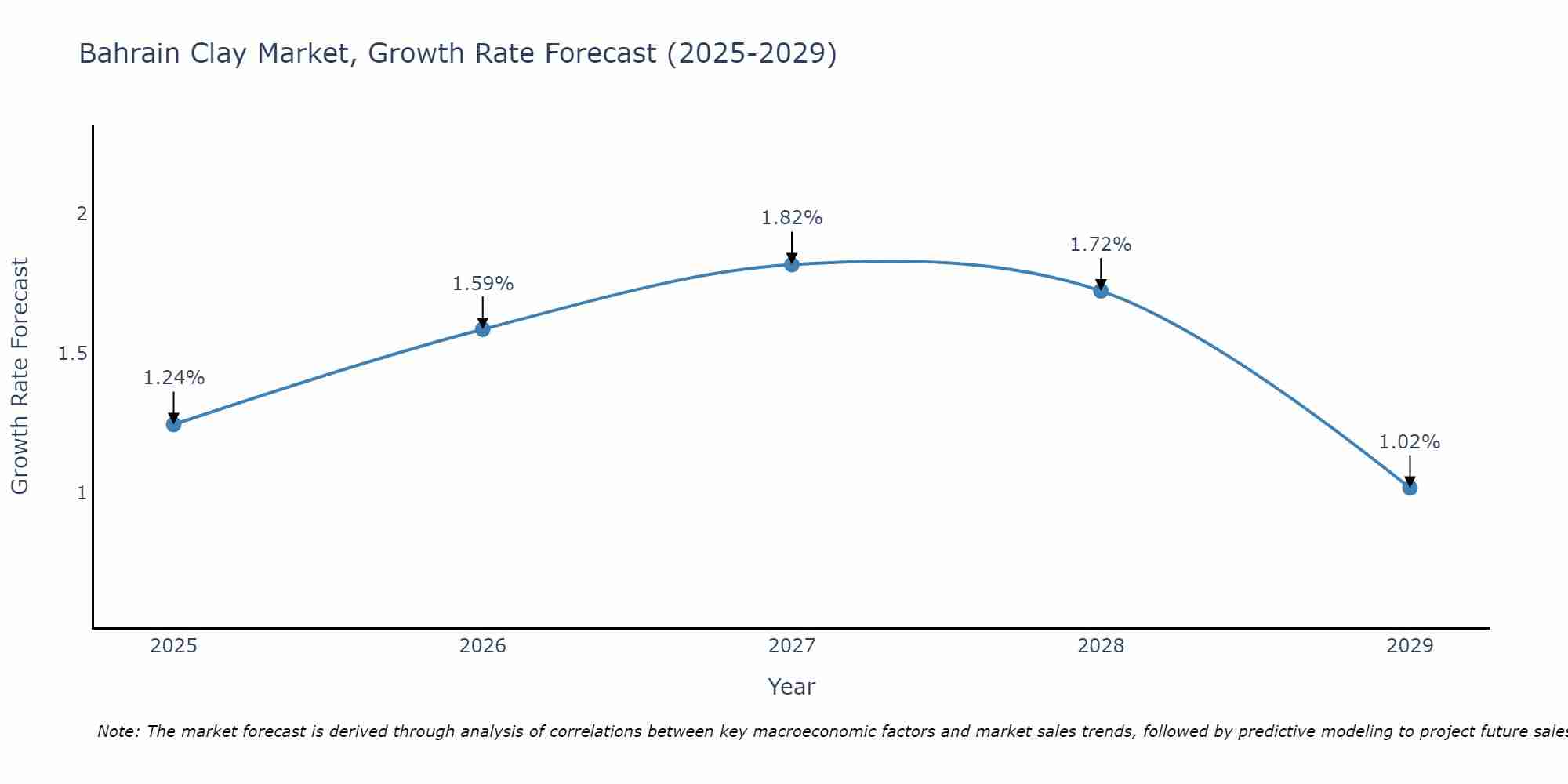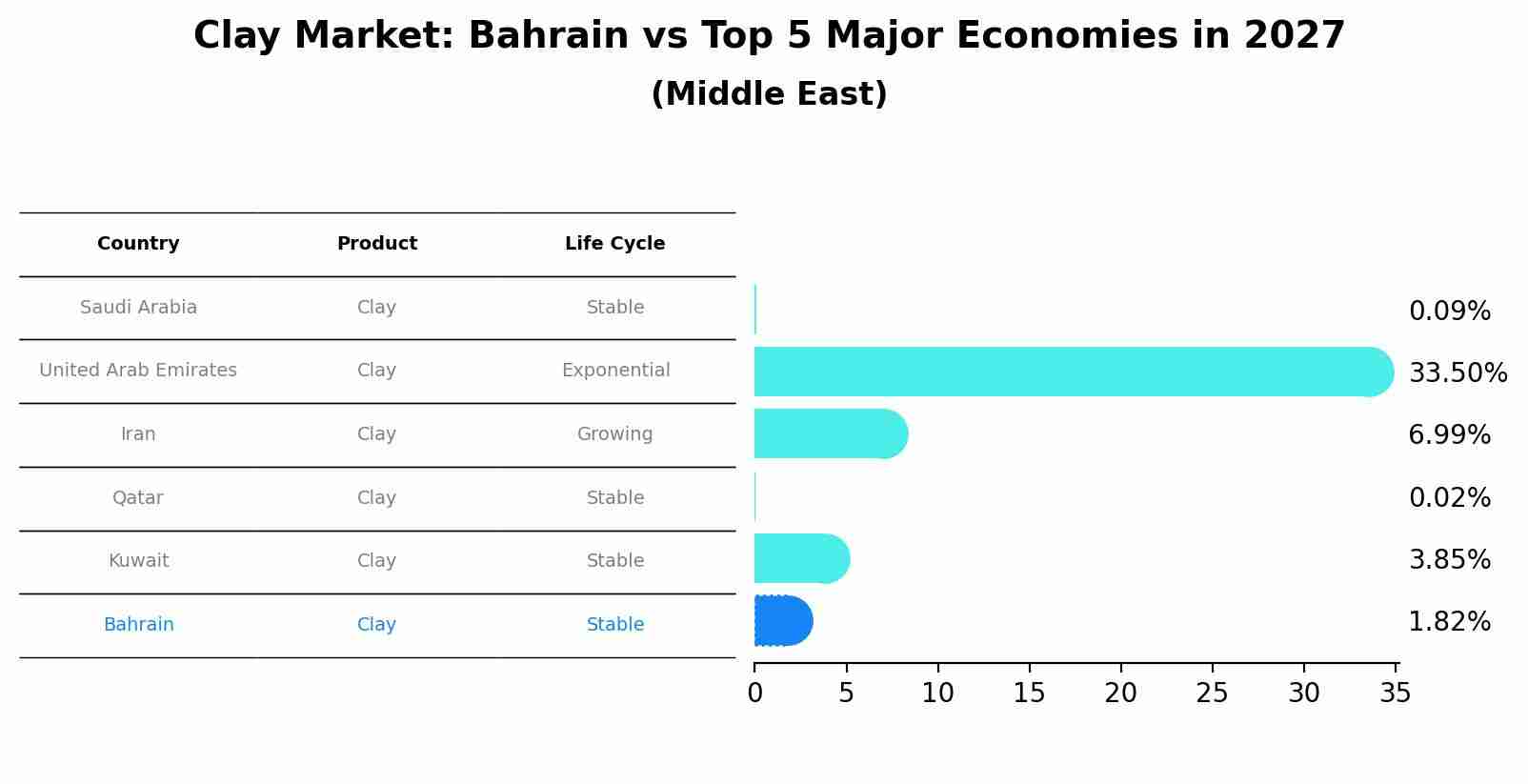Bahrain Clay Market Outlook | Trends, Forecast, Value, Growth, Companies, Industry, Analysis, Share, Size, COVID-19 IMPACT & Revenue
| Product Code: ETC319004 | Publication Date: Aug 2022 | Updated Date: Aug 2025 | Product Type: Market Research Report | |
| Publisher: 6Wresearch | Author: Shubham Padhi | No. of Pages: 75 | No. of Figures: 35 | No. of Tables: 20 |
Bahrain Clay Market Size Growth Rate
The Bahrain Clay Market is projected to witness mixed growth rate patterns during 2025 to 2029. Growth accelerates to 1.82% in 2027, following an initial rate of 1.24%, before easing to 1.02% at the end of the period.

Clay Market: Bahrain vs Top 5 Major Economies in 2027 (Middle East)
By 2027, the Clay market in Bahrain is anticipated to reach a growth rate of 1.82%, as part of an increasingly competitive Middle East region, where Saudi Arabia remains at the forefront, supported by United Arab Emirates, Iran, Qatar and Kuwait, driving innovations and market adoption across sectors.

Bahrain Clay Market
Clay, a naturally occurring mineral composed of fine-grained minerals such as kaolinite, montmorillonite, and illite, finds applications in various industries such as ceramics, construction, and cosmetics. In Bahrain, the clay market is witnessing steady growth driven by the expanding construction and manufacturing sectors. Clay is used as a raw material for manufacturing ceramics, bricks, tiles, and refractories. Moreover, it finds applications in construction materials such as cement, concrete, and plaster. With ongoing advancements in clay processing technologies and expanding application areas, the Bahrain clay market is expected to witness sustained growth.
Drivers of the market
The Bahrain Clay Market is driven by the increasing demand for construction materials, the rising applications in ceramics, refractories, and pottery, and the growing emphasis on sustainability and durability. Clay, a naturally occurring mineral composed primarily of hydrated silicates of aluminum, is valued for its plasticity, strength, and thermal resistance, making it a versatile material for various industrial and artisanal applications. The expanding construction sector, the rise of infrastructure development projects, and the growing interest in traditional crafts and pottery in Bahrain are driving the consumption of clay products. Moreover, the benefits of abundance, low cost, and recyclability associated with clay materials are further fueling market growth, enabling industries and artisans to create innovative and sustainable solutions for diverse applications effectively.
Challenges of the market
One of the challenges facing the Bahrain Clay Market is the competition from alternative raw materials such as synthetic clays, minerals, and recycled materials in ceramics, construction, and industrial applications. Additionally, concerns about clay quality, mining regulations, and environmental sustainability pose challenges for clay producers and users in Bahrain to ensure a reliable supply chain and product performance in diverse end-use sectors.
Government Policy of the market
Government regulations may govern mineral resources management, mining permits, and environmental regulations for clay extraction and processing. Policies may include mining concessions, environmental impact assessments, and land reclamation plans to ensure the sustainable and environmentally responsible development of clay resources in Bahrain.
Key Highlights of the Report:
- Bahrain Clay Market Outlook
- Market Size of Bahrain Clay Market, 2024
- Forecast of Bahrain Clay Market, 2031
- Historical Data and Forecast of Bahrain Clay Revenues & Volume for the Period 2018 - 2031
- Bahrain Clay Market Trend Evolution
- Bahrain Clay Market Drivers and Challenges
- Bahrain Clay Price Trends
- Bahrain Clay Porter's Five Forces
- Bahrain Clay Industry Life Cycle
- Historical Data and Forecast of Bahrain Clay Market Revenues & Volume By Application for the Period 2018 - 2031
- Historical Data and Forecast of Bahrain Clay Market Revenues & Volume By Tableware for the Period 2018 - 2031
- Historical Data and Forecast of Bahrain Clay Market Revenues & Volume By Sanitary ware for the Period 2018 - 2031
- Historical Data and Forecast of Bahrain Clay Market Revenues & Volume By Medical applications for the Period 2018 - 2031
- Historical Data and Forecast of Bahrain Clay Market Revenues & Volume By End Use for the Period 2018 - 2031
- Historical Data and Forecast of Bahrain Clay Market Revenues & Volume By Ceramic and for the Period 2018 - 2031
- Historical Data and Forecast of Bahrain Clay Market Revenues & Volume By Non-ceramic for the Period 2018 - 2031
- Bahrain Clay Import Export Trade Statistics
- Market Opportunity Assessment By Application
- Market Opportunity Assessment By End Use
- Bahrain Clay Top Companies Market Share
- Bahrain Clay Competitive Benchmarking By Technical and Operational Parameters
- Bahrain Clay Company Profiles
- Bahrain Clay Key Strategic Recommendations
Frequently Asked Questions About the Market Study (FAQs):
1 Executive Summary |
2 Introduction |
2.1 Key Highlights of the Report |
2.2 Report Description |
2.3 Market Scope & Segmentation |
2.4 Research Methodology |
2.5 Assumptions |
3 Bahrain Clay Market Overview |
3.1 Bahrain Country Macro Economic Indicators |
3.2 Bahrain Clay Market Revenues & Volume, 2021 & 2031F |
3.3 Bahrain Clay Market - Industry Life Cycle |
3.4 Bahrain Clay Market - Porter's Five Forces |
3.5 Bahrain Clay Market Revenues & Volume Share, By Application, 2021 & 2031F |
3.6 Bahrain Clay Market Revenues & Volume Share, By End Use, 2021 & 2031F |
4 Bahrain Clay Market Dynamics |
4.1 Impact Analysis |
4.2 Market Drivers |
4.2.1 Growing construction industry in Bahrain |
4.2.2 Increasing demand for sustainable and eco-friendly building materials |
4.2.3 Government initiatives promoting infrastructure development |
4.3 Market Restraints |
4.3.1 Fluctuating raw material prices |
4.3.2 Intense competition from alternative building materials |
5 Bahrain Clay Market Trends |
6 Bahrain Clay Market, By Types |
6.1 Bahrain Clay Market, By Application |
6.1.1 Overview and Analysis |
6.1.2 Bahrain Clay Market Revenues & Volume, By Application, 2021-2031F |
6.1.3 Bahrain Clay Market Revenues & Volume, By Tableware, 2021-2031F |
6.1.4 Bahrain Clay Market Revenues & Volume, By Sanitary ware, 2021-2031F |
6.1.5 Bahrain Clay Market Revenues & Volume, By Medical applications, 2021-2031F |
6.2 Bahrain Clay Market, By End Use |
6.2.1 Overview and Analysis |
6.2.2 Bahrain Clay Market Revenues & Volume, By Ceramic and, 2021-2031F |
6.2.3 Bahrain Clay Market Revenues & Volume, By Non-ceramic, 2021-2031F |
7 Bahrain Clay Market Import-Export Trade Statistics |
7.1 Bahrain Clay Market Export to Major Countries |
7.2 Bahrain Clay Market Imports from Major Countries |
8 Bahrain Clay Market Key Performance Indicators |
8.1 Average selling price of clay products |
8.2 Number of new infrastructure projects in Bahrain utilizing clay products |
8.3 Percentage of market share held by clay products compared to alternatives |
9 Bahrain Clay Market - Opportunity Assessment |
9.1 Bahrain Clay Market Opportunity Assessment, By Application, 2021 & 2031F |
9.2 Bahrain Clay Market Opportunity Assessment, By End Use, 2021 & 2031F |
10 Bahrain Clay Market - Competitive Landscape |
10.1 Bahrain Clay Market Revenue Share, By Companies, 2024 |
10.2 Bahrain Clay Market Competitive Benchmarking, By Operating and Technical Parameters |
11 Company Profiles |
12 Recommendations |
13 Disclaimer |
- Single User License$ 1,995
- Department License$ 2,400
- Site License$ 3,120
- Global License$ 3,795
Search
Related Reports
- ASEAN and Thailand Brain Health Supplements Market (2025-2031) | Strategy, Consumer Insights, Analysis, Investment Trends, Opportunities, Growth, Size, Share, Industry, Revenue, Segments, Value, Segmentation, Supply, Forecast, Restraints, Outlook, Competition, Drivers, Trends, Demand, Pricing Analysis, Competitive, Strategic Insights, Companies, Challenges
- ASEAN Bearings Market (2025-2031) | Strategy, Consumer Insights, Analysis, Investment Trends, Opportunities, Growth, Size, Share, Industry, Revenue, Segments, Value, Segmentation, Supply, Forecast, Restraints, Outlook, Competition, Drivers, Trends, Demand, Pricing Analysis, Competitive, Strategic Insights, Companies, Challenges
- Europe Flooring Market (2025-2031) | Outlook, Share, Industry, Trends, Forecast, Companies, Revenue, Size, Analysis, Growth & Value
- Saudi Arabia Manlift Market (2025-2031) | Outlook, Size, Growth, Trends, Companies, Industry, Revenue, Value, Share, Forecast & Analysis
- Uganda Excavator, Crane, and Wheel Loaders Market (2025-2031) | Strategy, Consumer Insights, Analysis, Investment Trends, Opportunities, Growth, Size, Share, Industry, Revenue, Segments, Value, Segmentation, Supply, Forecast, Restraints, Outlook, Competition, Drivers, Trends, Demand, Pricing Analysis, Competitive, Strategic Insights, Companies, Challenges
- Rwanda Excavator, Crane, and Wheel Loaders Market (2025-2031) | Strategy, Consumer Insights, Analysis, Investment Trends, Opportunities, Growth, Size, Share, Industry, Revenue, Segments, Value, Segmentation, Supply, Forecast, Restraints, Outlook, Competition, Drivers, Trends, Demand, Pricing Analysis, Competitive, Strategic Insights, Companies, Challenges
- Kenya Excavator, Crane, and Wheel Loaders Market (2025-2031) | Strategy, Consumer Insights, Analysis, Investment Trends, Opportunities, Growth, Size, Share, Industry, Revenue, Segments, Value, Segmentation, Supply, Forecast, Restraints, Outlook, Competition, Drivers, Trends, Demand, Pricing Analysis, Competitive, Strategic Insights, Companies, Challenges
- Angola Excavator, Crane, and Wheel Loaders Market (2025-2031) | Strategy, Consumer Insights, Analysis, Investment Trends, Opportunities, Growth, Size, Share, Industry, Revenue, Segments, Value, Segmentation, Supply, Forecast, Restraints, Outlook, Competition, Drivers, Trends, Demand, Pricing Analysis, Competitive, Strategic Insights, Companies, Challenges
- Israel Intelligent Transport System Market (2025-2031) | Strategy, Consumer Insights, Analysis, Investment Trends, Opportunities, Growth, Size, Share, Industry, Revenue, Segments, Value, Segmentation, Supply, Forecast, Restraints, Outlook, Competition, Drivers, Trends, Demand, Pricing Analysis, Competitive, Strategic Insights, Companies, Challenges
- Uganda Precast and Aggregate Market (2025-2031) | Strategy, Consumer Insights, Analysis, Investment Trends, Opportunities, Growth, Size, Share, Industry, Revenue, Segments, Value, Segmentation, Supply, Forecast, Restraints, Outlook, Competition, Drivers, Trends, Demand, Pricing Analysis, Competitive, Strategic Insights, Companies, Challenges
Industry Events and Analyst Meet
Our Clients
Whitepaper
- Middle East & Africa Commercial Security Market Click here to view more.
- Middle East & Africa Fire Safety Systems & Equipment Market Click here to view more.
- GCC Drone Market Click here to view more.
- Middle East Lighting Fixture Market Click here to view more.
- GCC Physical & Perimeter Security Market Click here to view more.
6WResearch In News
- Doha a strategic location for EV manufacturing hub: IPA Qatar
- Demand for luxury TVs surging in the GCC, says Samsung
- Empowering Growth: The Thriving Journey of Bangladesh’s Cable Industry
- Demand for luxury TVs surging in the GCC, says Samsung
- Video call with a traditional healer? Once unthinkable, it’s now common in South Africa
- Intelligent Buildings To Smooth GCC’s Path To Net Zero













